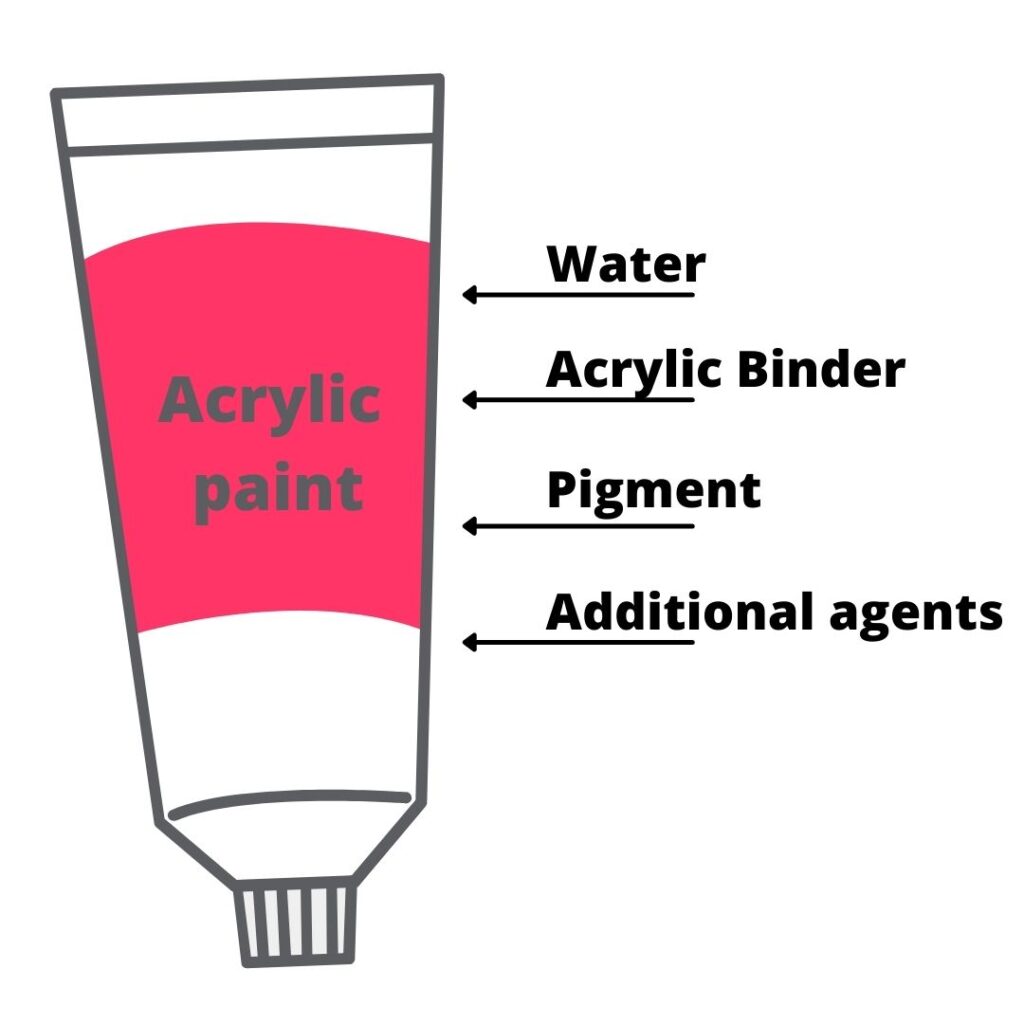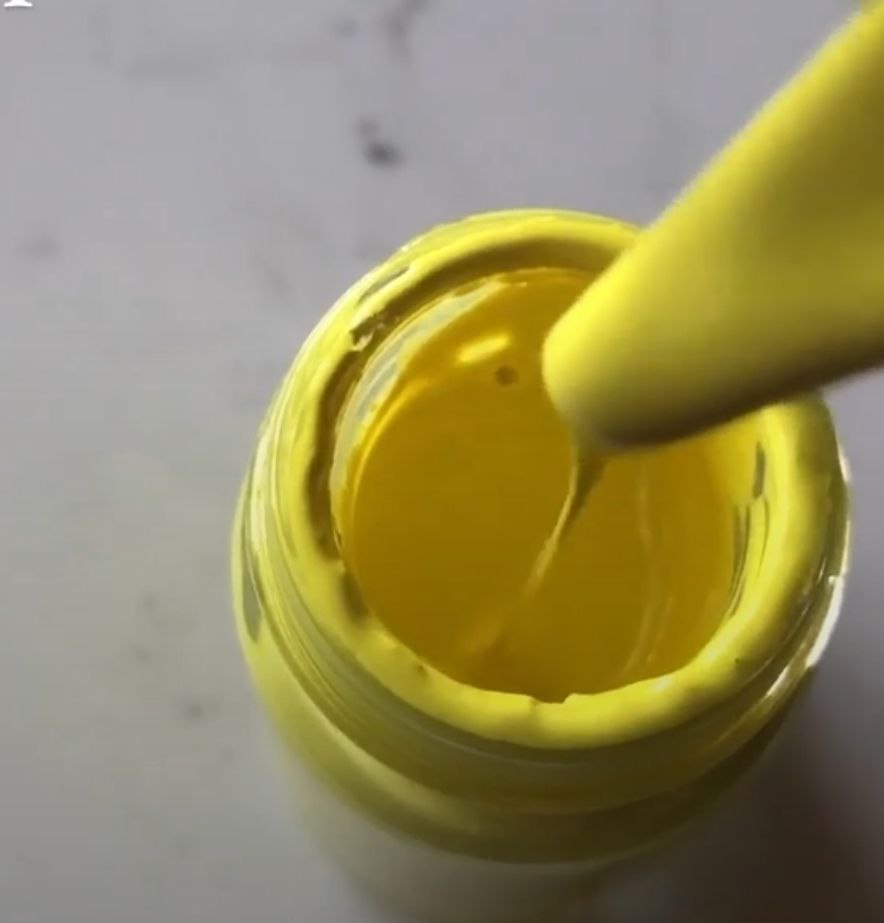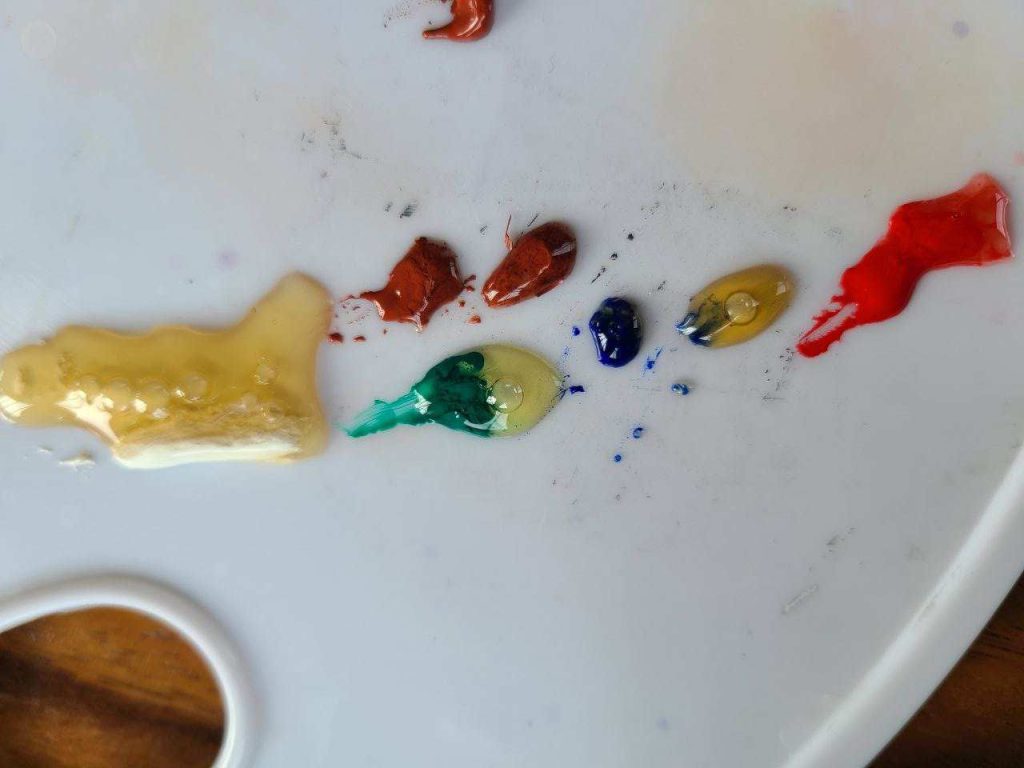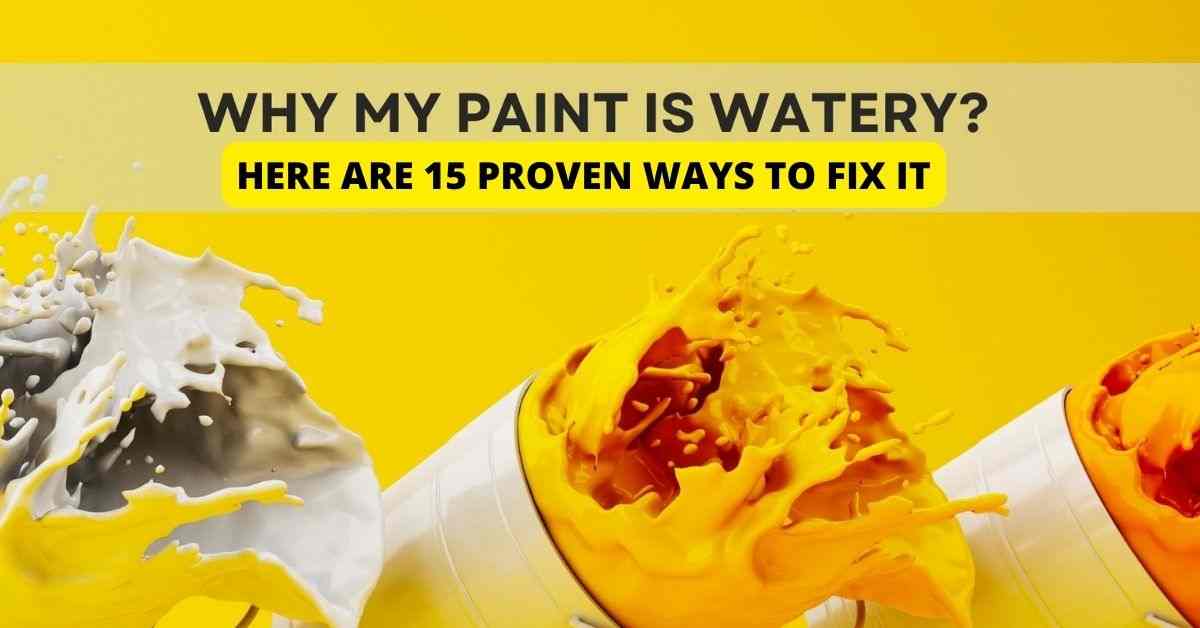Last Updated on November 19, 2023 by Masha Eretnova
Why is my paint watery? That’s one common problem of an artist and probably the worst nightmare! It can disrupt your artistic process or even destroy your entire artistic work. What should you do? Do you just throw it out?
Your paint may be watery because it has been sitting still for a long time, it’s gone bad, or you added too much water or fluid medium to the paint. Stir it for 5 min., or you can use gel mediums, HEC powders, sand, and other alternatives to fix runny paint.

To eliminate that frustration away, we’re here to help you! Let’s fix that watery paint so that you can achieve the perfect quality for your artistic project. Read more on the 5 proven ways to make your next artwork go as smoothly as possible.
Table of Contents
4 Main Ingredients of Paint

First, we have to talk about the main ingredients of paint. They play an essential role in the consistency of your paint, regardless of its brand.
1. Pigment – It is the colorant added to paint. It may come synthetically or from grin up minerals or plant material.
2. Binder – It holds all the other ingredients together and helps keep the paint from drying. For acrylics, it is a polymer.
3. Solvent – It dissolves or disperses different formulation components. However, for acrylic paints, the solvent used is water.
4. Additives – The purpose of it is to improve the quality of the paint, so it will be some preservatives against mold, UV, etc.
8 Reasons Why Paint Is Watery

Paint becomes watery for many reasons. But here are common reasons why:
- Paint tends to get watery when left unattended for a long time, especially latex, emulsion, or acrylic paint. It can become more watery the longer it sits. The same happened to one of my poster and gouache paints as well.
- After a long time of not being used, oil paint and enamel paint are known to separate. When you finally open it, you might see too much liquid and it is actually an oil, that is separated from the paint.
- Old paint is more likely to be watery or liquid.
- The viscosity could be too watery or thick if you have low-quality paint or happen to get just a defective can of paint.
- The improper ratio of paint/water is one of the most common causes. So your acrylic paint may become watery if you add too much water. It is best to add 30% max of water to acrylic paint for perfect consistency.
- You added too much pouring medium and didn’t stir well.
- You bought fluid or pouring paint! It is supposed to be quite thin. Check the label.
- You haven’t stored the paint property or the store you bought it from didn’t follow the storage guidelines.
Read how to properly thin paint here: How to Thin Acrylic Paint: 3 Correct Ways & 3 Dont’s
Why is my acrylic Paint watery?
If you’re using acrylic paint, you can stumble with thin and watery acrylic paint. And there are 3 reasons for this.
- You have bad-quality acrylic paint because good acrylic paint is thick enough (heavy body) to show your brush strokes clearly and is easy to use with the palette knife.
- Acrylic paint sits in the tube for a while under too much heat (temperature higher than 25C)
- You might dilute your paint with too much water or thinner
Make sure to buy one of the 21 best acrylic paints for beginners that I kindly reviewed for you!
Acrylics won’t become watery on the palette, quite the opposite, they will harden.
You can thicken acrylic paint using one of the methods I share below.
Why is my latex paint watery?
The most common reason latex paint is too watery is that it has not been shaken thoroughly before use. If this is the case, the components that give latex paint its elasticity and adhesive qualities can separate.
After thoroughly shaking your latex paint, wait about 15 minutes before using it to let any sediment or air bubbles fall to the bottom of the container.
Why is fence paint so watery?
Fence paint is the paint you will use to protect wood and fence preserver. But why is it so watery?
It usually depends on what type of paint you use on your fence. For example, water-based paint tends to be thinner than oil-based paints. Also, how you mix your paint can affect the thickness of the final product.
So if you find yourself with watery paint that doesn’t stick to your fence, the best solution is to try mixing the paint well because the pigments have settled at the bottom.
But if it doesn’t fix this, your paint has gone bad. You might want to go to the paint store and get a new paint.
Why is wall paint so watery?
If you’ve ever painted a room, you may have experienced your paint drips off of the walls and slopes down toward your feet. Frustrating, isn’t it? You don’t have to worry. There’s a way to fix that!
The most common reason your wall paint is so watery is you did not mix it properly. So to solve this, make sure you mix them enough.
Make sure you have enough ventilation before you begin to thicken your paint. It could take several hours for thickened paint to dry, so practice patience.
Why is my spray paint watery?
The first and most obvious reason is that it sat in the can for too long. Spray paint oxidizes over time. It can happen because of air exposure and other factors like temperature changes and humidity levels.
Another reason your spray paint might be watery is something was blocking off part of the nozzle on top of the canister. Insufficient airflow prevents pressure release during use and releases more liquid at once.
Why is my paint pen watery?
Artists love paint pens because you can draw almost anything with them! You can even use them to paint on rocks and decorate your pots and cups.
Paint won’t flow into the nib of your paint pen when you don’t use it for a while and the pigment has dried out. It causes the inside pigment to thicken, which causes the water base to reach the tip before the dense colored pigment.
To solve this problem, shake the paint pen vigorously for 20 to 30 seconds. You can hear the ball inside the marker mixing the ink. You can also try giving your cells a few light taps on a hard surface to help break the pigment.
I had some bleeding pens in my experience and some of them got better after a while, some became completely unusable. I have not yet had such issue tho with these Artistro paint pens.
Why is my chalk paint watery?
Chalk paint is a water-based paint. So if you add too much water to it, it will make the consistency thin or watery. It can also be too runny if you didn’t mix it properly before applying it or the paint has gone bad.
But, you can solve the issue by letting the lid open and then stirring. The mixture evaporates during this period, slightly changing the proportion of water in chalk paint.
Another method to thicken your chalk paint is to mix an additional dry mixture. It wasn’t an option when you bought pre-mixed chalk paint.
The recommended ratio for perfect chalk paint consistency is 12 tablespoons of calcium carbonate in every quart of flat-based paint. Or you can use ⅓ cup of plaster Paris, ⅓ cup of water, and 1 cup of paint. This mixture always works well for me!
You should also check these best chalk paint brushes to make your artwork perfect!
How To Tell If The Paint Is More Watery Than It Should Be?
First, look at the consistency of the paint. If there are chunks of dried-out paint in it, that means the consistency is too thick. If it’s runny and watery, or you can see a liquid layer sitting on top of the paint, then it’s probably too thin.
The more watery your paint is, the more likely it will drip and cause splatter. And while this can be great if you’re looking for some abstract expressionism, it can be hell if you’re trying to keep your floors clean. Not to mention that watery paint takes too long to dry and can buckle the paper or make canvas too saggy.
Additionally, if it takes you longer than normal to cover an area or canvas with the paint or several coats, your paint is more watery than it should be.
Read also: How Long Does Acrylic Paint Take to Dry? 30 Brands Drying Time
You can also determine if there is a color shift. If your paint turns out lighter than you expected or there is a slimy underlayer that indicates your paint is watery.
Lastly, the paint should not be runny but flow easily when you pour it. It is best to use floetrol or another pouring medium rather than water.
So, let’s get into the proven ways to fix watery paint!
Sometimes the paint isn’t watery but it is the binder that got separated from the pigment. It happens with cheap paint sometimes when it sits on the shelf too long. It happened to me with Reeves gouache paint and it looked like this:

You can still mix it back on the palette, but sometimes the separation has gotten too far and it just makes no sense trying to save it.
15 Proven Ways To Fix Runny And Watery Paint
There is a variety of ways to fix runny and watery paint. From stirring and shaking to thickening agents, you can get your paint to greater consistency in just a few minutes.
Please note, that hair products cannot thicken paints, don’t try it 🙂
1 – Shake and/or Stir
The easiest way to fix your watery pain is to shake or stir it. You will feel resistance while dipping and stirring a wooden stick or rod inside a can of paint. The solid components have sunk to the bottom, and the liquid has floated.
It typically occurs when your paint’s liquid and solid components separate while being stored for too long. It mostly happens to the paint in cans, like latex or wall paints.
Giving your paint a few stirs for about 3-4 minutes can help mix the paint’s liquid and solid components.
Shaking also works for paint pens if they are too watery to properly mix the pigment and the solvent. Shake it for about a minute, then press the tip against the paper a few times to see the paint coming out. Use a paper towel to wipe the excess liquid.
If your paint is in the bottle, I recommend storing it with mixing balls inside so you can easily shake it when needed. It will improve the quality and lifetime of the paint.
2 – Use Paint Thinner for Oil-based Paint
It may seem weird to use thinner on watery paint. It works well only on oil-based paints! If stirring your oil-based paint doesn’t work, thick chunks of paint may be at the bottom and we need to dissolve them to re-mix the paint properly.
Ratio: 1 part thinner to 3 parts oil paint. Stir for 2 minutes getting to the bottom of the jar/can or transfer the paint to a container.
Impasto may work as a turpentine substitute as well.
Although it might seem that thinning out your paint wouldn’t do any good, it can work effectively by removing any thick chunks and smoothing the paint throughout the entire can.
3 – Use Hydroxyethyl Cellulose For Latex Paint
Hydroxyethyl Cellulose (HEC) is a chemical and an additive that you can add to paint to make it less runny. HEC comes in powder form and dissolves as you add it with water or solvent. HEC is a thickening agent that acts as an “anti-freeze” for your paint.
Ratio: 25% HEC of the volume of the latex paint.
It will thicken the consistency of any thin or watery paints without making them grainy or lumpy, or changing color, as other additives might. It will thicken your mixture pretty fast but doesn’t last forever. After about six months or so, the viscosity of your paint will drop back down again.
4 – Add Gel or Paste Mediums to Improve Your Paint
Dry mediums alter the texture and appearance of your paint by making it thicker, thinner, or by adding color. Adding dry mediums to your paint can improve the texture of your work while also making it less watery.
You can add mediums like Liquitex Gel Medium to your acrylic paint to make it thicker. You must keep in mind that the amount of gel you use should not be more than 1/4 the amount of paint you are using. Another good option is Liquitex Thickenning Medium – only a small amount will make the paint more stable and oil-like.
Alternatively, you can use impasto mediums or modeling pastes. But add only a tiny bit first as their initial purpose is to make paint really thick for textured painting.
5 – DIY Paint Thickener to Tempera Paint
Another cheaper way to thicken your paint is making household thickening agents. It is a good way to fix watery tempera paint. Talcum powder is another option to thicken acrylic paint.
- You will need 4 teaspoons of cornstarch and 3 cups of water.
- Mix them on low heat and stir until the cornstarch is dissolved.
- Cool it down! Don’t add hot mixture to the paint!
- And add it to your watery tempera paint.
Some people also substitute cornstarch with flour, heavy milk, sawdust, salt or sugar, or even play-doh but I’m not sure how it will work with paint 🙂
The cornstarch (talcum) method can also lead to cracks so be careful!
6 – Use Paper Towel To Fix Drips on Canvas
When you apply it to your canvas, there will be times when you find your paint is too watery. And how frustrating can it be? The easiest way to fix it is to dampen a paper towel to your canvas to absorb the water.
After you have damped a paper towel, mix your paint with less water to achieve the perfect viscosity you’re trying to achieve!
7 – Use Beeswax And Turpentine For Oil-based Paints
- Combine 3 parts turpentine with 1 part beeswax.
- Mix them and add them directly to your palette with your oil-based paint.
- Stir all together until you achieve your desired thickness.
8 – Sand A Runny Wall Paint
If you work with wall paint and it is too runny on the wall and left some drips, you can sand it.
- Before it dries, remove any drips you see when painting with a dry brush or roller. It is easy to fix wet paint than dried paint.
- Sand the drip area gently until it has flattened out.
- After that, stir your paint, and apply another coat.
9 – Throw A Bad Paint
Paints don’t last forever, and that’s the truth. Latex and water-based acrylic paints can last up to 10 years if never opened.
And if it’s opened, the paint will normally last up to 2 years if you keep it closed tightly and kept in a dry, cool location. The cheaper the paint the faster it may go bad.
Read also: Best Acrylic Paint: 21 Brands Reviewed for Beginners [From Cheap to Pro]
And unopened oil-based paints can last for up 15 years. After being opened, oil-based paint will last for about one year.
After trying all the ways mentioned to fix runny and watery, but it doesn’t work, you will need to throw it.
10 – Add more layers
If you work with acrylic or oils sometimes the first layer may seem watery. In this case, wait until it dries completely and apply the second layer. It may enhance the color and the coverage.
Working with acrylics always use thin layers. Thick layers may seem easy to apply, but they will take longer to dry and may lead to cracks!
11 – Add sand to make the paint thick and textured
If you don’t mind adding a little bit of texture to your paint, you can actually add sand to your paint.
The key is to strain the sand through a fine mesh beforehand to make sure it is all tiny particles and has no dirt.
Stir it well for around 15 minutes.
12 – Add Calcium Carbonate (Marble dust) to watery Chalk paint
You can make your own chalk paint by mixing Calcium Carbonate Powder, water, and latex paint. Calcium carbonate is also called marble dust or chalk dust.
In the same way, if you already have a can of paint, you can add a few tablespoons of calcium carbonate to see if it will thicken the paint.
13 – Contact the brand
If you bought a good artist-grade paint like DecoArt, Liquitex, Golden, or Winsor & Newton, their customer services are very responsive, and may be willing to exchange your watery paint with a new tube!
Don’t buy no-name brands on Amazon that don’t even have official websites or contacts. Who will you contact If something is wrong?
You can also ask them what should you do to fix the paint. Most brands always send very detailed replies.
For ex., with my issue with Reeves gouache Australian branch was quick to act and tried to explain the situation to me, but unfortunately not all departments are that effective. As I bought that specific Reeves set in Bali, I had to contact them which I did, but never got any reply…
14 – Add Joint Compound to Runny Wall Paint
Another alternative to fix watery paint is adding a joint compound or drywall mud. But it may cause color shift and texture so I would recommend to very careful with it and trying all the other methods first.
How to mix paint with joint compound:
- 1 cup of joint compound goes in a container
- Then you should add paint by good tablespoons to monitor the consistency and the color.
15 – Drain the water
If you see literally water in your palette, you can simply drain it or dry it with paper towel.
Tips To Make Acrylic Paint Less Watery
- Add no more than 30% of water, better even limit it to 25%. Don’t mix too much water with your acrylic while painting. If your acrylics are thin and getting too runny, try adding more medium instead of more water.
- Instead of water and DIY mediums, use professional flow mediums and gels. They keep the quality of the paint high and don’t lead to unexpected results.
- Do not skip stirring and shaking.
- Store your acrylic paint properly. Acrylic paints can become watery if you expose them to heat. If you work with acrylic regularly and plan to use your paints for a long time, it’s best to keep them in an airtight container at room temperature.
- You can use paste or gel if you want to thicken your acrylic. The paste is thick and adds a chunky texture, while the gel is thinner in consistency and adds a glossy finish. Both are great for adding different effects to your project.
Read also: 15 Proven Ways How to Make Acrylic Paint Dry Slower & Homemade Acrylic Paint Retarder Recipe
Can You Water Down Acrylic Paint?
It is possible to water down your acrylic paints. You may achieve this by either using an acrylic medium or water. You can mix up to 50 % water with acrylic paint to get wash effects like watercolor.
But the manufacturers say you should only use 25-30% water. If you add too much, the paint will lose its consistency and won’t stick together. And it will result in your paint peeling, cracking or the paint losing its strength.
If you are watering down wall paint or latex paint in big cans, add no more than 2-4 cups of water for every 5 gallons (19 L) of paint.
Read also: How to Thin Acrylic Paint: 3 Correct Ways & 3 Dont’s
FAQs
How do you make watery paint thicker?
It usually depends on what paint you are using because each paint has different ways to increase the viscosity. If you’re using latex paint, you can thicken the paint by using hydroxyethyl cellulose. With the right amount, you will get the right consistency of your paint.
But if you want to thicken your oil paint, simply mix it with thinner or dry mediums. With this method, the texture of your paint will change, and it will probably be less watery. Start with a small amount of each dry medium and slowly add more until you get the consistency you want.
And for acrylic paint, you can use pastes and gels to improve the viscosity of your paint.
Read also: 14 Ways How to Make Acrylic Paint Thicker: A Comprehensive Guide
Can you use old watery paint?
The good news is, YES! Unopened, properly stored paint is almost always used. Unopened latex and water-based acrylic paints can survive 10 years, and oil-based paints up to 15 years.
Opened paints may still be usable, but you must test them first. Test the paint on cardboard after stirring. Your paint is safe if it usually goes. If not, you need to get a new one!
Why does the paint go runny?
Paints become runny from using an overloaded paintbrush to applying too much paint to your object in one coat. Excess water or the quality of the paint can also be a reason why.
The good news is that you can fix this even after they have dried, and it will be even simpler if you notice them while the paint is still wet.
Can You Use Watery Paint?
You can use watery paint to make your painting look like watercolor. But if you want better coverage and you are sure the paint is still good, try to thicken it by stirring, adding gel or thickening mediums or DIY thickeners.
Wrap Up
Most people know that painting is not an easy task. A beautiful work of art needs time, skill, and effort. However, most people don’t know some common reasons why your paint is watery and how you can fix it.
You can try these 15 proven ways to fix this problem. You can always start by stirring or shaking your paints. But if it doesn’t work, you can try using this thickener, thinner for oil-based paints and dry mediums.
Hopefully, this post has helped you understand why your paint is watery and, better yet, given you ways to solve the problem!
Read also:
- How to Fix Lumpy & Chunky Acrylic Paint? [10 Easy Methods]
- How To Fix Cracked Acrylic Painting in 3 Easy Ways

Masha Eretnova, born in 1991, is a Buenos Aires-based certified teacher, artist, and member of the Professional Artist Association with 20+ years of personal painting journey.
She started painting and drawing very early and is now an international abstract artist and educator passionate about acrylic painting, gouache, and crafts.
Her works are part of international exhibitions and contests, including ArtlyMix (Brazil), Al-Tiba 9 (Spain), Exhibizone (Canada), Italy, and many more.
Besides her artistic pursuits, Masha holds a post-grad diploma in Teaching Film Photography and 2 music school diplomas: piano and opera singing.
